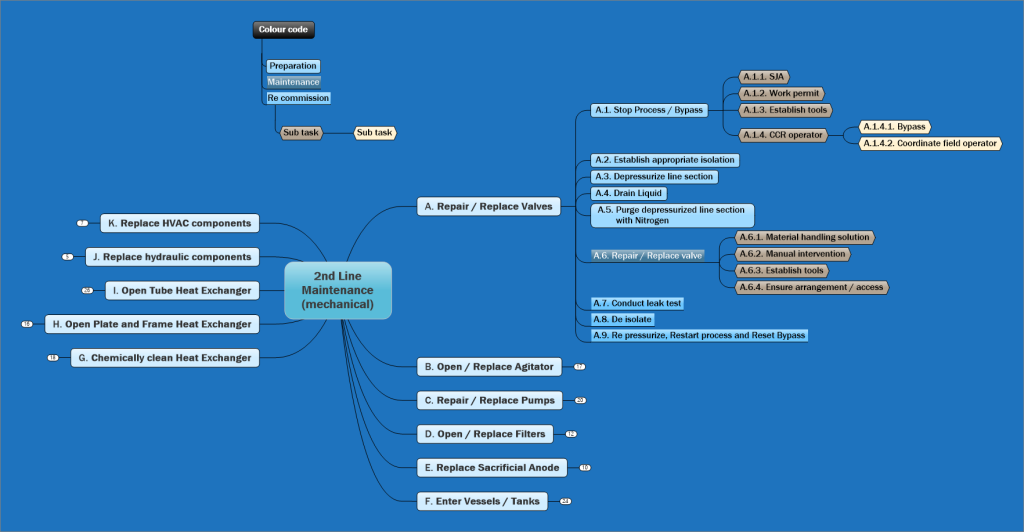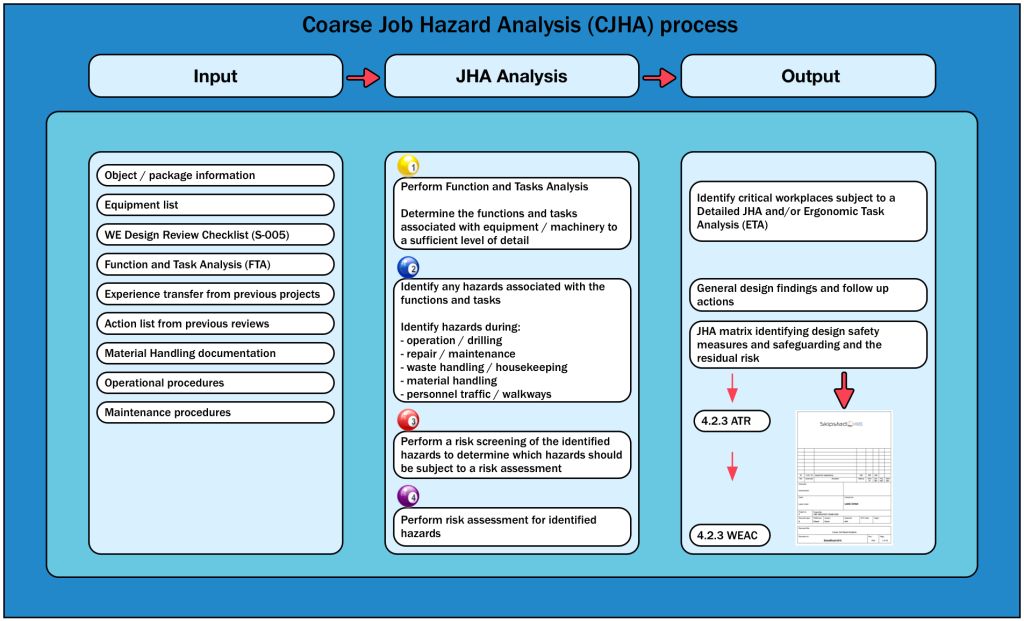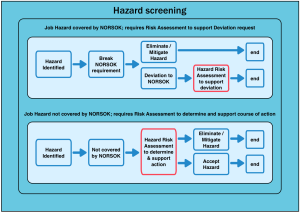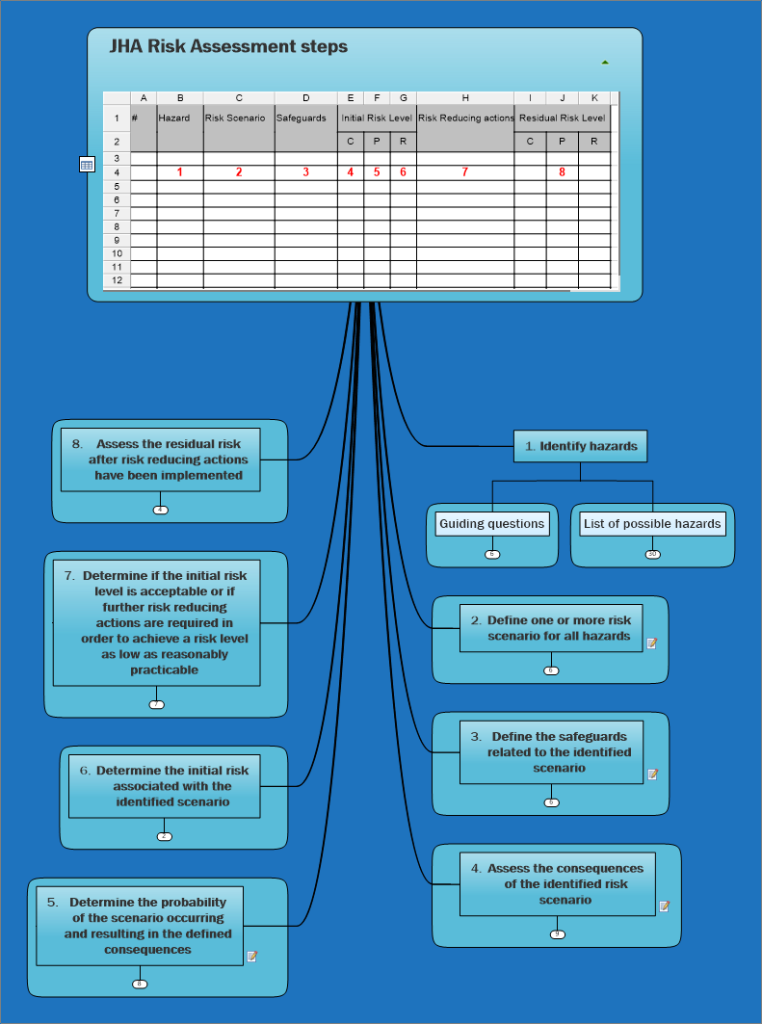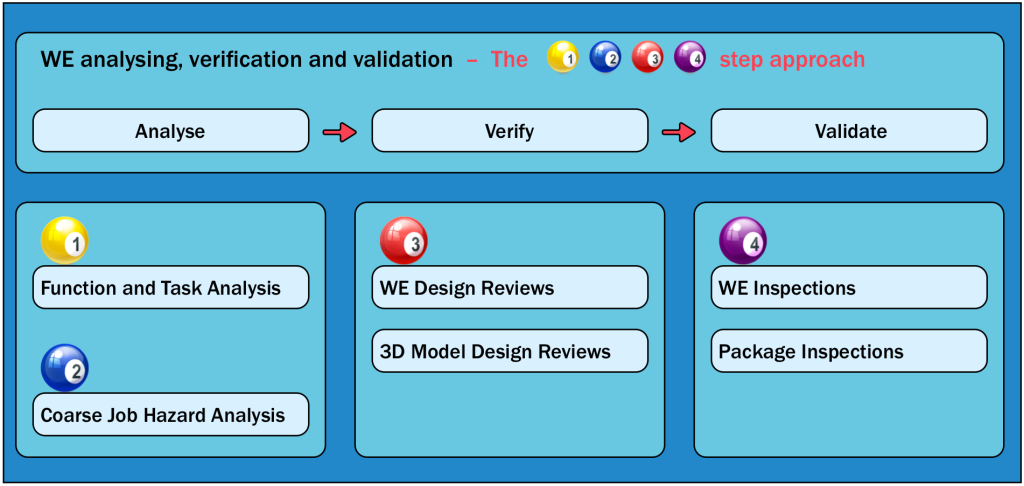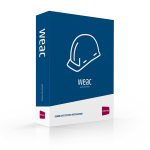WE - Activities
Experience based design is preferred and transfer of experience from operations to development projects is a good investment. It is important for projects that known good design solutions are identified and implemented and bad solutions are avoided in design.
Sources of experience may include:
- Function and Task Analysis from previous projects
- Experience data from other projects
- Earlier modifications to improve working environment
- Good technical solutions
- Solutions/equipment to be preferred or avoided
- Statistics on occupational accidents and injuries, near-accidents and work-related diseases
- Results of working environment surveys and risk assessments
These resources may or may not be easily available. Either way experience transfer activities should be performed.
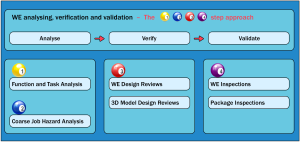 Involving experienced end users in the project and make them available
Involving experienced end users in the project and make them available
for working environment activities is the best way to ensure experience transfer. The 4 step process is one approach where end users should be involved. The earlier they are involved the better. End user involvement in all activities will in fact ensure experience transfer throughout the project. It also means experience is provided when needed and the more detailed a project becomes the more and better experience transfer will be identified.
A Function and Tasks Analysis should be the first activity performed and be the basis for collecting experience transfer data. An FTA is a structured and easy method to understand the borders and limitations for the analysed object. It provides a good overview of functions and related work tasks and ensure we all (the project) understand scope and operational requirements and needs. During the FTA experience transfer brainstorming will identify any problems or success factors related to the function or tasks. It is essential that relevant engineers and experienced end users participate in the FTA.
In concept engineering (FEED), detailed engineering and construction phases further experience transfer should be based on involving the right people. Company should provide experience transfer by making available experienced end users that can participate in the various WE activities (e.g. the 4 step process).
We think experience transfer should be built into a process of activities but in some cases it may also useful to develop a separate experience transfer report. The approach will depend on the project phase, the project complexity and the resources available.
Important outcome:
The experience transfer activity shall identify installation areas and vendor packages that need particular attention during design development and identify adequate requirements for these areas and packages.
Keep in mind! We have worked up a lot of experience and this will of course benefit your project.
Need more information?
Please contact us, together we find the best experience transfer solution for you.
An organisation and manning study is required for a new development as input to several other project activities/studies and to ensure that the operation phase is adequately catered for in the design of the new facility.
The study should describe the various personnel categories in the platform organization, their skills, experience, responsibilities and operations / maintenance tasks, and the distribution of working hours by area.
The study should include sufficient details regarding frequency / duration of tasks to be able to:
- Confirm preliminary manning levels (defined by WEAL and listed in WEAC)
- Determine the means of access/egress
- Determine ergonomic workplace requirements
- Perform job hazard analyses
- Perform risk assessment of chemical exposures
- Provide input to other WE activities
Sources of input to study:
- Operation and maintenance philosophy for the field and project
- Experience data from other projects
- Design basis
- Function and Task Analysis if these have been established by project
It is quite useful if the organisation and manning study is based on function and task analyses which has been developed for the project. This will ensure a better understanding for how work will be organised and make it easier to verify if manning is at a level sufficient to safeguard activity peaks, operational interruptions and hazard and accident situation.
Need more information?
Please contact us, together we find the best way to perform your organisation and manning study.
As input to detailed engineering, a systematic analysis of the preconditions for a safe, efficient and health-promoting interaction between the worker and the environment should be performed. The purpose is to analyze organisation, manning, and workplace design in order to identify potential problem areas related to psychosocial WE in particular.
For various positions on the facility the analysis should include an evaluation of the psychological job demands and the preconditions for social interaction/support and control at work. The analysis should also consider the preconditions for rest during the time off at the facility.
Based on the psychosocial analysis the psychosocial working environment criteria should established as input to detailed design. These criteria should be included in Functional Specification, Design Basis and Scope of Work documents.
This can be a stand alone psychosocial evaluation but we think its better that the manning and organization study are elaborated to include analysis of psychosocial preconditions.
During engineering it is also acceptable for similar workplaces and work areas to assess psychosocial factors using empirical data from operations phases.
Need more information?
Please contact us, together we find the best way to asses the psychosocial preconditions.
Function and task analysis (FTA) is a methodology which is supported by a number of techniques to help us collect information, organise it, and then use it to make various judgments or design decisions.
Various techniques may be used to analyse and present the information. The choice of technique will be determined by the specific area of application, the nature of task, the level of criticality and the detail needed to establish design requirements.
For oil and gas projects the FTA may be presented graphically describing the functions and tasks relating to a skid, working / lay-down area, rooms, decks or discipline (e.g. catering). We use the method to establish all activities on facility early in the concept phase. The information collected is then used as basis for all other activities.
The FTA should be performed as part of the Job Hazard Analysis preparation, and should collect function and task information for normal operations, preventive and corrective maintenance.
The FTA should identify equipment, related functions and tasks, which worker is likely to carry out (e.g. operations, maintenance, operations supervisor, campaign team etc.), describe the subtasks, frequency and (in some cases) estimated time for completion.
The FTAs should be established during concept phase and be revised and updated in FEED phase, in detailed engineering and construction phases.
An FTA example for a typical function is shown below. This is a typical work process related to valve maintenance and information is provided at a coarse level. Together with experience data and known working methods for valve maintenance the FTA should be detailed to a level sufficient for performing the JHA and assessing the hazards related to maintenance of valve.
Typical FTA´s may be made for functions and tasks that are similar across the facility. Specific FTA´s must be made for equipment packages, work areas, etc.
The more information that is received the more detailed the FTA can be made and better can our analysis be made. In the end we will achieve better results and better designs.
Need more information?
Please contact us, together we find the best way to perform the function and task analyses.
The aim of a Job Hazard Analysis (JHA) is to identify and evaluate the acute hazards, to which employees are exposed when performing work activities, and to establish elimination or control measures that will protect the worker from health risk or injury. (NORSOK S-002)
Our approach for a JHA is to identify and understand the hazards that may arise during the course of activities on facility. It can then be decided whether the risks to people, equipment or the environment arising from these hazards are acceptable or tolerable. Where risks are not tolerable, actions (e.g. equipment redesign, barriers, procedures or training) can be assigned to remedy this.
The figure shows the overall process related to performing a JHA and the final outcome.
A Coarse JHA should be carried out for each of the work areas on the facility. This will serve to identify any general hazards across the facility. It will also identify critical workplaces or tasks (those with a high risk of accidents or ergonomic stresses), for which a Detailed JHA should be carried out.
Coarse and detailed JHA differ in the level of detail into which the activities are subdivided.
Each JHA should take the form of a structured assessment of information, and will involve project personnel and representatives of relevant user groups (for example, mechanical engineers, production technicians, and the safety delegate). The operational experience provided by those involved is useful in identifying hazards that would not otherwise be uncovered.
In our approach for the JHA there is four key steps:
Step 1 function and task analysis
This means a step-by-step breakdown of the functions and tasks associated with equipment / machinery to a sufficient level of detail.
Step 2 hazard identification
Use the FTA to uncover any biological, chemical, physical / ergonomic and psychological hazards associated with tasks.
Step 3 hazard screening
Hazard risk assessment may use a lot of time and resources if performed for all functions and tasks on the facility. We think its important that we spend time and resources on activities that adds value for the project. Thus in the JHA process we use an approach where we do a screening of hazards to identify if a risk assessment is needed. We assume the project has set its acceptance criteria (normally NORSOK and company specific requirements) and if those criteria is met then the working environment design will be acceptable.
Our risk screening approach:
The first case is where a hazard is found that contravenes a NORSOK requirement. There are two courses of action available to the design team; either to mitigate against the hazard in accordance with NORSOK or to accept the deviation. The Hazard Risk Assessment can thereby support this course of action. Another reason for conducting the Risk Assessment is where a hazard is not covered by NORSOK. In this case, the identified risk may be used to determine and support the resulting action.
A systematic approach from early project phases will help identify any problems and this screening approach will reduce the need for risk assessment. The earlier hazards are identified the easier it is to eliminate or mitigate hazard. Instead of spending time on risk assessments in the project phase personnel can focus on finding acceptable design solutions that eliminate or mitigate the risk.
Step 4 hazard risk assessment
Hazards found should be risk rated using a scenario based approach, defining consequences and probability of occurrence, and the need for further risk reducing actions.
For all hazards subject to a risk assessment:
- Identify hazards
- Determine the risk scenario (how can the hazard harm people, environment, reputation and/or assets?)
- Define the scenario safeguards (already implemented risk reducing measures)
- Determine the severity of the identified scenario consequences
- Determine the probability of the scenario occurring
- Determine the initial risk using your companies WE Risk Matrix
- Determine whether the risk is acceptable or if further risk reducing actions are required in order to achieve a risk level as low as reasonably practicable
- Determine the residual risk level if risk reducing measures where proposed
During the risk assessment it may be concluded that more details are required. I.e. the tasks must be further broken down. At this stage we will assess whether a more detailed JHA is required in order to fully determine the risk level.
A detailed JHA will follow the same format as the coarse JHA, but work activities will be examined in greater detail using a more detailed FTA.
The risk assessment steps:
Need more information?
Please contact us, together we find the best way to perform the job hazard analyses.
Ergonomic Task Analyses (ETAs) shall be performed during engineering to identify potential problem areas in workplace design, and to ensure that the maximum workload requirements can be met. (NORSOK S-002)
In theory workplaces shall be designed such that the personnel are not exposed to excessive workloads with risks of musculoskeletal injury.
We can provide ETAs for all the workplaces but we think this may not be required if we see the ETA requirement in a bigger picture.
A well performed coarse job hazard analysis may be the basis for deciding if and where an ETA is needed. A good JHA process will analyse all workplaces and will provide good basis to identify workplaces involving tasks in operation or maintenance with a significant risk of musculoskeletal injuries. Thus, there will be a well documented and justified decision that define an FTA is required.
In most cases the JHA is sufficient to identify ergonomic risks and risk can be eliminated or mitigated without the need for ETA. However for some functions and task the risk is more complex and further assessments may be needed before a decision is made.
We must then perform an ETA.
An ETA will cover operation, maintenance and inspection tasks to a finer level of detail than the Coarse JHA function and tasks analyses.
ETAs will include the following information, as appropriate:
- Manning (including number, job titles, key skills and experience in similar tasks; personnel selection)
- Work sequences (making reference to operation instructions or maintenance manuals where appropriate)
- Frequency of each operation
- Equipment used to perform tasks
Analyses based on the ETAs should include evaluations of:
- Access and clearances
- Equipment layout
- Location of work functions (displays, control actuators, manually operated valves, etc.)
- Viewing conditions
- Repetitive movements
- Lifting and transportation aids
- Manual handling
- Sedentary work
As stated above, ETAs should be produced only as required, based on the findings of JHA meetings.
Operators or personnel with relevant knowledge / experience of similar tasks and functions should be enlisted to help develop the ETAs.
Need more information?
Please contact us, together we find the best way to perform the function and task analyses.
A Working Environment Impact Assessment (WEIA) analysis should be performed during the concept selection phase to identify installation areas and vendor packages that need particular attention during design development and to provide input to concept selection and validation of the selected concept. The analysis should be updated during concept definition and optimization/FEED, to summarize WE aspects of the selected concept as input to detailed engineering. (NORSOK S-002)
This is often seen as a stand alone activity during the concept selection phase.
The purpose of activity is to identify potential risks to be followed up as the project develops and to assess the impacts of the chosen design solution.
We can provide the WEIA as a standalone deliverable but we prefer to start the 4-step approach in concept phase. We believe a systematic and iterative process used throughout the various project phases will provide more detailed input and better understanding and control of the identified hazards and risk. A continuous focus on human risks help us select the best possible design solutions from a health and working environment perspective.
A stand alone WEIA performed during concept phase according to NORSOK should cover but not be limited to the following potential problem areas:
- Accidents and musculoskeletal injuries when handling heavy materials and drilling equipment. The analysis should include important issues regarding arrangements of permanent access and transportation routes, lifts, platform crane operations, lay-down areas, and material handling of equipment > 1000 kg. For drilling modules, the pipe-handling arrangements and equipment should be included.
- Exposure to cold stress/wind chill in open and semi-open areas. When considered necessary, the analysis should include preliminary calculations of WCI, see NORSOK S-002 section 4.4.9.
- Storage and handling of hazardous substances.
- Storage of bulky equipment and materials, e.g. containers, scaffolding.
- Noise and vibration-emitting equipment and areas with noisy activities adjacent to quiet areas, see NORSOK S-002 section H.5.1.
- Solitary work in permanently manned areas.
WEIA should include assessment of:
- Job hazard/risk of occupational injuries
- Ergonomics/prevention of musculoskeletal strains and Injuries
- Ergonomics/human factors in work systems
- Hazardous chemicals
- Noise and vibration control
- Illumination
- Outdoor operations/cold stress
- Constructability
The resulting extent of relevant analyses should be based on qualified identification.
Need more information?
Please contact us, together we find the best way to perform the ergonomic task analyses.
During project development, a Chemicals Health Risk Assessment (CHRA) should be performed to identify, evaluate and control chemical health risks to an acceptable level.
The Chemicals HRA should be performed for all activities where hazardous chemicals are planned for use during operations or maintenance and for all processes containing hazardous chemicals that are or can be emitted to the working environment.
Our chemical HRA will be use the FTA and the JHA to define all chemicals to be used on the facility. As such there is important that activities are performed in right order and that focus is on gathering the information needed.
It is also important that suppliers of machinery identify and document in an inventory all chemical substances that are contained within machinery boundaries and/or are planned to be used in connection the machinery. Ref NORSOK S-005 section 5.4.
The Chemical HRA will be performed according to NORSOK S-002 section 4.4.6 and comply with requirements listed in to NORSOK S-002 section 5.4.
When completed, the Chemicals HRA will document the following as input to design:
- All chemicals (actual or typical) to be used, including substances used in and/or released from processes
- Information about health hazard
- The localization of major chemical emitting sources and their influences
- Estimated / calculated exposure levels of airborne chemicals and skin contaminants related to planned activities, including inspection, sampling, maintenance and cleaning activities
- The need for exposure barriers, including need for general and/or local ventilation and enclosure of sources
- The need for storage areas
- The need for emergency showers and eyewash stations
Need more information?
Please contact us, together we find the best way to perform the Chemical HRA.
Project design reviews are normally performed at 30%, 60% and 90% complete designs. These are design reviews covering all disciplines and focus perhaps on risk at a higher level.
We believe dedicated working environment design reviews (WEDR) should be performed in addition to overall project design reviews.
Design reviews should be performed to verify compliance with specific WE requirements and to identify any needs for corrective measures. They should cover the whole facility and be based on performed WE analysis such as Coarse JHA’s.
While the FTA and JHA is a proactive approach to analyse work environment, the WEDR is a reactive activity to verify that problems have been solved properly and also that the measures implemented has not triggered any other design problems.
WE design reviews should be performed in all phases. They should not in any circumstances be combined or replaced by JHA, risk assessments or other project activities. The review activity should be seen as a tool to be in control of risks and ensure that output from each phase are established as design criteria and design basis for next phase.
We prefer to perform WEDR as small workshops where relevant project personnel is involved. 3D models and checklist together with FTA´s and overview of all observations (ATR, WEAC) will be used to verify compliance.
The results and findings will be documented in a report and/or the action tracking register.
WEDR is step 3 in our 4-step approach.
Need more information?
Please contact us, together we find the best way to perform the WE design reviews.
Working Environment Inspections (WEI) should be carried out to verify compliance with established design requirements and that action from WE analyses are implemented.
Inspections during construction should take place while rectification work is still possible. It means inspection should be performed not later than 80% complete. However, just one inspection at 80% complete may not be the best approach to discover design faults. We believe continuous and systematic inspections at the construction site will provide better control and ensure any issues are found as early as possible.
Inspection at vendor facilities for machinery and equipment may be performed once. A complex and large package may however need more than one inspection.
We have performed several hundreds inspections the last 20 years and gained much experience. We have a trained eye that spot irregularities, design and construction errors. We will provide recommendations that will solve the problems and ensure acceptable solutions are implemented satisfactory.
A good plan is essential and solid preparations is needed to perform effective inspections that covers all working environment factors.
We will develop a good and realistic inspection plan and preferably we would include this in the overall project plan to ensure inspections follow fabrication plan.
In our opinion, inspections should be performed until all actions have been closed.
Inspections will be led by ourselves and the inspection team will consist of personnel from relevant disciplines and representatives from operations.
The results and findings will be documented in a report and/or in the action tracking register.
WEI is step 4 in our 4-step approach.
Need more information?
Please contact us, together we find the best way to perform the WE inspections.
In order to comply with NORSOK S-002 the Working Environment Area Charts (WEACs) shall be prepared to document status regarding implementation of WE requirements.
In principle, a working environment area status should be prepared for each room and area on the installation. However, to maintain a manageable number of area charts, several areas with identical requirements (e.g. escape routes) may be covered by a single WEAC.
WEACs should be issued at predefined project milestones.
The WEACs should include the results of predictions and verification measurements (e.g. as-built data for illumination and noise), and should describe identified problem areas and non-conformities as well as the status regarding decisions on remedial actions.
The WEAC is often seen by users as a time consuming activity which doesn't give any value for the project. It is more seen as a documentation activity to satisfy requirements.
We believe this is unfortunate. The WEAC should be seen as a valuable tool for the WE engineer an the project.
The WEAC activity if performed correct can be a very useful resource for the project and a place where the working environment status can be continuously monitored throughout the project and into operation.
The WEAC should be the tool that support responsible WE engineer in performing activities, to verify compliance and to follow up actions. The WEAC should be used to document status within the project and to management and external partners.
Proteus WEAC (Working Environment Area Chart) is a software suite which has been developed by Promineo together with us. This tool provides a systematic and effective solution for mapping the working environment. The tool documents status regarding implementation of working environment requirements.
It has been designed to be the helping hand for the responsible WE engineer and make their project day to day work more efficient.
Some of the functions provided by the tool:
- Full control of area limits and predictions, calculated and measured values of all quantitative WE factors (noise, vibration, illumination, temperature etc.)
- A system where WE activities such as FTA, JHA, ETA, WEDR and WEI can be completed.
- Standardised report formats for WE activities such as FTA, JHA, ETA, WEDR and WEI.
- A system for collecting experience transfer data
- A system for handling non-conformances and technical queries
- A system collecting relevant information and documentation (e.g. Reports, minutes of meetings, etc.)
- Action tracking register (ATR)
- Statistics, i.e. findings status per area
- Status overview per area, room, level etc
We recommend use of the Proteus WEAC tool and can help set up the tool, provide guidance on use and help planning activities for efficient interaction with tool.
There is a license cost for the tool but we will argue this cost is easily saved through less resources needed as the work to deliver on NORSOK S-002 can be made much more efficient with the Proteus WEAC tool as the assistant.
If hired on the project we would recommend that a license is bought for use of Proteus WEAC so that we can deliver state of the are working environment solutions and designs.
A solution which take the NORSOK S-002 WEAC activity to a higher level.
Need more information?
Please contact us, together we find the best way to map the working environment.
The following are deliverables which must be initiated once project has been kicked off. These activities are normally performed/headed by the WE responsible engineer during the concept evaluations or during FEED.
- WE Program and plan
- WE Area Limits
- WE acceptance criteria
- Access philosophy based on arrangement/means of access study
- Follow up system
- Outdoor operations evaluations
- Technology evaluation including BAT
We have the expertise and experience and can deliver on all these activities.
Need more information?
Please contact us, together we find the best way to organise these activities.
Some engineering disciplines have important deliverables to be provided as input for the working environment analysis. The deliverables has also a direct impact on the work environment design for the whole facility.
It is important that the WE responsible engineer are in control of these discipline activities and ensure that engineering is performed and information is made available for the other working environment analysis and activities when needed. In the end a faulty delivery from either of the disciplines may lead to a design which cannot be accepted.
The following activities are delivered by other engineering disciplines:
- Noise and vibration control (S-002)
- Illumination studies (S-002)
- Indoor climate assessments (air quality and temperature) (S-002)
- Material handling studies (R-001)
- Technical safety studies (S-001 and S-012)
- Architectural activities (C-001 and C-002)
We have the expertise and experience and knows what is required from the disciplines. We can coordinate the work and ensure engineering disciplines are involved when required. We can also perform some of the work or help out getting the work done.
Need more information?
Please contact us, together we find the best way to organise these activities.

